Friday, June 22, 2007
Cordillera Blanca (Peru'), 15 -21 Giugno - ITALIANO
Huaraz, 15 Giugno 2007
Cordillera Blanca, Cordillera Huaywash: due catene montuose mitiche, ed a giusta ragione. Si tratta delle catene montuose tropicali piu' estese al mondo, ma sopratutto e' qui che si trovano le montagne che rispetto alla loro altitudine - compresa fra 5700 e 6600 metri - presentano le ascensioni tecnicamente piu' difficili in America del Sud. Nomi come Siula Grande, Jirishanca, Ranrapalca, Artensoraju, Alpamayo evocano anche al semplice appassionato di montagna paesaggi leggendari, difficili ascensioni e racconti di disperate ascensioni. Probabilmente qualcuno di voi ha visto "Touching the Void", ad ogni modo le foto che mettero' su questo blog parleranno da solo.
Sono a Huaraz, il luogo che per eccellenza rapprensenta l'alpinismo in Peru'. Per le prossime cinque settimane Huaraz sara' la nostra "base", da qui in compagnia di Mike arrivato l'altro ieri dalla calda California organizzeremo le prossime scalate.
Domani partiremo in direzione della Quebrada Paron, dove si situano i nostri primi due obiettivi: il Paron (5665m) e l'Artensoraju (6025m), ascensioni rispettivamente di livello AD (abbastanza difficile) e D (difficile). L'Artensoraju e' la classica piramide di ghiaccio ed intendiamo scalarla lungo una ripida parete di neve e ghiaccio con pendenza che aumenta progressivamente fino a 60-65 gradi nella sezione terminale. Domani lasceremo Huaraz ed in serata stabiliremo il nostro primo campo all'ingresso della Quebrada Paron (Quebrada si puo' tradurre in italiano con vallata). Da li' ci renderemo ai margini del ghiacciaio per stabilire il campo alto dal quale scalare le due montagne. Per queste due scalate sceglieremo di procedere in puro stile alpino leggero, senza l'aiuto di animali da carico.

Campo base Quebrada Paron (4800m), 17 Giugno 2007
Eccoci al limite del ghiacciao Paron, abbiamo appena terminato di allestire il nostro campo base. Siamo a 4800 metri, su una morena e come previsto non siamo soli. L'Artensoraju e' una montagna molto popolare; sei alpinisti del Colorado hanno allestito il loro campo a pochi metri da noi e piu' giu' ci sono due australiani.

Per dirla tutta l'Artensoraju non e' solo una montagna popolare, ma anche assassina. Durante la marcia di avvicinamento abbiamo visto diverse targhe poste in memoria di alpinisti caduti negli anni passati e probabilmente queste rappresentano solo una frazione di uomini e donne che sono caduti nel tentativo di superare i propri limiti, nel tentativo di avvicinarsi e di essere parte della grandezza della natura che nella maestosita' della montagna trova la sua piu' grande espressione.
Domani tenteremo la scalata del Paron, un obiettivo di medio livello anche se le condizioni della neve sembrano davvero lasciare a desiderare.

Campo base Quebrada Paron (4800m), 21 Giugno 2007
Sono le nove del mattino. Avrei voluto lasciare le mie impressioni circa quello che abbiamo vissuto negli ultimi giorni con maggiore continuita' ma negli ultimi giorni sono stato davvero troppo stanco per aggiornare quotidianamente questo diario. Le ultime cinque giornate sono state davvero dure. Quattto giorni fa abbiamo provato a scalare il Paron ma su insistenza di Mike abbiamo deciso di fare dietro-front a circa cento metri dalla vetta. La neve era priva della minima consistenza e per ore ci siamo ostinati a procedere affondando fino alla cintura come se stessimo attraversando le sabbie mobili.

Circa duecento metri di dislivello sono stati vinti attraversando una pendenza di circa 50 gradi finche' non ci siamo resi conto che con il calore del Sole eravamo nelle classiche condizioni nelle quali si innesca una valanga. Fermarsi a cento metri dalla vetta e' stata una scelta frustrante ma probabilmente una saggia decisione.

Ieri abbiamo lasciato il campo base all'una della notte per scalare l'Artensoraju. Dopo circa dieci ore di scalata su neve e ghiaccio lungo una parete con pendenza culminante a 65 gradi siamo arrivati in vetta all'Artensoraju ma purtroppo la nebbia ed il maltempo ci ha privato della meravigliosa vista che sicuramente da li' si deve godere sull'intera Cordillera Blanca. La scalata di questa meravigliosa piramide di ghiaccio e' stata difficile ma niente in confronto alla discesa.

La prima sezione - dalla vetta fino ai 5500 metri - l'abbiamo percorsa calandoci in corda doppia con l'aiuto di ancoraggi posti da precedenti alpinisti. Gli ultimi quattrocento metri li abbiamo discesi in libera. E' stato necessario mantenere tutta la concentrazione possibile per non ritrovarsi centinaia di metri piu' giu' inghiottiti dal crepaccio che divide la faccia Sud-Est dell'Artensoraju dalla base del ghiacciaio. Proprio durante questa delicata discesa l'annos scorso tre statunitenti persero la vita.
Siamo tornati al campo base poco dopo le cinque del pomeriggio e dopo una breve ma sostanziosa cena sprofondati nel calore dei nostri sacchi a pelo.
Questa mattina quando il caldo del Sole si e' aggiunto a quello del sacco a pelo convincendomi a scrivere. Fra una mezz'ora cominceremo ad impacchettare tutto il materiale, se troveremo un veicolo nel pomeriggio in serata dovremmo essere a Huaraz. I prossimi tre giorni saranno di puro riposo prima di muoverci verso la Cordillera Huaywash con l'obiettivo di scalare il Rasac ed il Jirishanca.
Restano ventinove giorni al ritorno a casa.
Cordillera Blanca, Cordillera Huaywash: due catene montuose mitiche, ed a giusta ragione. Si tratta delle catene montuose tropicali piu' estese al mondo, ma sopratutto e' qui che si trovano le montagne che rispetto alla loro altitudine - compresa fra 5700 e 6600 metri - presentano le ascensioni tecnicamente piu' difficili in America del Sud. Nomi come Siula Grande, Jirishanca, Ranrapalca, Artensoraju, Alpamayo evocano anche al semplice appassionato di montagna paesaggi leggendari, difficili ascensioni e racconti di disperate ascensioni. Probabilmente qualcuno di voi ha visto "Touching the Void", ad ogni modo le foto che mettero' su questo blog parleranno da solo.
Sono a Huaraz, il luogo che per eccellenza rapprensenta l'alpinismo in Peru'. Per le prossime cinque settimane Huaraz sara' la nostra "base", da qui in compagnia di Mike arrivato l'altro ieri dalla calda California organizzeremo le prossime scalate.
Domani partiremo in direzione della Quebrada Paron, dove si situano i nostri primi due obiettivi: il Paron (5665m) e l'Artensoraju (6025m), ascensioni rispettivamente di livello AD (abbastanza difficile) e D (difficile). L'Artensoraju e' la classica piramide di ghiaccio ed intendiamo scalarla lungo una ripida parete di neve e ghiaccio con pendenza che aumenta progressivamente fino a 60-65 gradi nella sezione terminale. Domani lasceremo Huaraz ed in serata stabiliremo il nostro primo campo all'ingresso della Quebrada Paron (Quebrada si puo' tradurre in italiano con vallata). Da li' ci renderemo ai margini del ghiacciaio per stabilire il campo alto dal quale scalare le due montagne. Per queste due scalate sceglieremo di procedere in puro stile alpino leggero, senza l'aiuto di animali da carico.

Campo base Quebrada Paron (4800m), 17 Giugno 2007
Eccoci al limite del ghiacciao Paron, abbiamo appena terminato di allestire il nostro campo base. Siamo a 4800 metri, su una morena e come previsto non siamo soli. L'Artensoraju e' una montagna molto popolare; sei alpinisti del Colorado hanno allestito il loro campo a pochi metri da noi e piu' giu' ci sono due australiani.

Per dirla tutta l'Artensoraju non e' solo una montagna popolare, ma anche assassina. Durante la marcia di avvicinamento abbiamo visto diverse targhe poste in memoria di alpinisti caduti negli anni passati e probabilmente queste rappresentano solo una frazione di uomini e donne che sono caduti nel tentativo di superare i propri limiti, nel tentativo di avvicinarsi e di essere parte della grandezza della natura che nella maestosita' della montagna trova la sua piu' grande espressione.
Domani tenteremo la scalata del Paron, un obiettivo di medio livello anche se le condizioni della neve sembrano davvero lasciare a desiderare.

Campo base Quebrada Paron (4800m), 21 Giugno 2007
Sono le nove del mattino. Avrei voluto lasciare le mie impressioni circa quello che abbiamo vissuto negli ultimi giorni con maggiore continuita' ma negli ultimi giorni sono stato davvero troppo stanco per aggiornare quotidianamente questo diario. Le ultime cinque giornate sono state davvero dure. Quattto giorni fa abbiamo provato a scalare il Paron ma su insistenza di Mike abbiamo deciso di fare dietro-front a circa cento metri dalla vetta. La neve era priva della minima consistenza e per ore ci siamo ostinati a procedere affondando fino alla cintura come se stessimo attraversando le sabbie mobili.

Circa duecento metri di dislivello sono stati vinti attraversando una pendenza di circa 50 gradi finche' non ci siamo resi conto che con il calore del Sole eravamo nelle classiche condizioni nelle quali si innesca una valanga. Fermarsi a cento metri dalla vetta e' stata una scelta frustrante ma probabilmente una saggia decisione.

Ieri abbiamo lasciato il campo base all'una della notte per scalare l'Artensoraju. Dopo circa dieci ore di scalata su neve e ghiaccio lungo una parete con pendenza culminante a 65 gradi siamo arrivati in vetta all'Artensoraju ma purtroppo la nebbia ed il maltempo ci ha privato della meravigliosa vista che sicuramente da li' si deve godere sull'intera Cordillera Blanca. La scalata di questa meravigliosa piramide di ghiaccio e' stata difficile ma niente in confronto alla discesa.

La prima sezione - dalla vetta fino ai 5500 metri - l'abbiamo percorsa calandoci in corda doppia con l'aiuto di ancoraggi posti da precedenti alpinisti. Gli ultimi quattrocento metri li abbiamo discesi in libera. E' stato necessario mantenere tutta la concentrazione possibile per non ritrovarsi centinaia di metri piu' giu' inghiottiti dal crepaccio che divide la faccia Sud-Est dell'Artensoraju dalla base del ghiacciaio. Proprio durante questa delicata discesa l'annos scorso tre statunitenti persero la vita.
Siamo tornati al campo base poco dopo le cinque del pomeriggio e dopo una breve ma sostanziosa cena sprofondati nel calore dei nostri sacchi a pelo.
Questa mattina quando il caldo del Sole si e' aggiunto a quello del sacco a pelo convincendomi a scrivere. Fra una mezz'ora cominceremo ad impacchettare tutto il materiale, se troveremo un veicolo nel pomeriggio in serata dovremmo essere a Huaraz. I prossimi tre giorni saranno di puro riposo prima di muoverci verso la Cordillera Huaywash con l'obiettivo di scalare il Rasac ed il Jirishanca.
Restano ventinove giorni al ritorno a casa.
Tuesday, June 12, 2007
Machu Picchu, ovvero come farsi derubare, 8-11 giugno 2007 - ITALIANO
Cusco, 12 giugno 2007
Machu Picchu ovvero accettare per amore della cultura o per soddisfare la propria curiosita' di farsi derubare indegnamente. Non credo che occorra la minima introduzione per descrivere le rovine di Machu Picchu. Tutti abbiamo visto almeno una volta una fotografia di questa splendida citta' Inca, scoperta da un archeologo inglese nel 1911 dopo che per secoli era stata inghiottita dalla foresta.
Quello che forse non e' noto e' il triste ed indecente commercio che il governo peruviano fa' di questa meraviglia.
Il solo ingresso alle rovine costa la bellezza di 40 dollari, ma non basta. Una volta pagato l'ingresso ci si ritrova su un sito privo del benche' minimo pannello esplicativo. Perche? Beh, per costringere i visitatori a noleggiare una delle costosissime guide per la cifra di dieci dollari a persona, in un gruppo di almeno sei. Il prezzo e' per una lingua come lo spagnolo, l'inglese o il francese, non oso sapere quanto costa una guida che parla giapponese o tedesco. Non basta, bagni e deposito bagagli sono a pagamento.
Naturalmente a meno di avere il teletrasporto occorre rendersi sul sito e questo, lo potrete immaginare, e' lontano dall'essere gratuito. Al sito ci si rende in treno, non v'e' alernativa a meno di non fare tutto il cammino a piedi (cio' che ho fatto, ma si tratta in tutto di circa quaranta chilometri, sola andata). Il treno che da Cusco arriva ad Aguas Calientes, la stazione piu' vicina alle rovine costa la bellezza di 70 dollari (andata e ritorno) e questo nella classe piu' bassa. Una volta ad Aguas Calientes il servizio di autobus per rendersi all'ingresso delle rovine costa ancora 12 dollari. In pratica la visita alle rovine - escludendo le necessita' alimentari e diuretiche e senza noleggiare una guida - costa 120 dollari.
E dire che il sito e' classificato quale "Bene mondiale dell'Umanita'"!
Machu Picchu ovvero accettare per amore della cultura o per soddisfare la propria curiosita' di farsi derubare indegnamente. Non credo che occorra la minima introduzione per descrivere le rovine di Machu Picchu. Tutti abbiamo visto almeno una volta una fotografia di questa splendida citta' Inca, scoperta da un archeologo inglese nel 1911 dopo che per secoli era stata inghiottita dalla foresta.
Quello che forse non e' noto e' il triste ed indecente commercio che il governo peruviano fa' di questa meraviglia.
Il solo ingresso alle rovine costa la bellezza di 40 dollari, ma non basta. Una volta pagato l'ingresso ci si ritrova su un sito privo del benche' minimo pannello esplicativo. Perche? Beh, per costringere i visitatori a noleggiare una delle costosissime guide per la cifra di dieci dollari a persona, in un gruppo di almeno sei. Il prezzo e' per una lingua come lo spagnolo, l'inglese o il francese, non oso sapere quanto costa una guida che parla giapponese o tedesco. Non basta, bagni e deposito bagagli sono a pagamento.
Naturalmente a meno di avere il teletrasporto occorre rendersi sul sito e questo, lo potrete immaginare, e' lontano dall'essere gratuito. Al sito ci si rende in treno, non v'e' alernativa a meno di non fare tutto il cammino a piedi (cio' che ho fatto, ma si tratta in tutto di circa quaranta chilometri, sola andata). Il treno che da Cusco arriva ad Aguas Calientes, la stazione piu' vicina alle rovine costa la bellezza di 70 dollari (andata e ritorno) e questo nella classe piu' bassa. Una volta ad Aguas Calientes il servizio di autobus per rendersi all'ingresso delle rovine costa ancora 12 dollari. In pratica la visita alle rovine - escludendo le necessita' alimentari e diuretiche e senza noleggiare una guida - costa 120 dollari.
E dire che il sito e' classificato quale "Bene mondiale dell'Umanita'"!
Sunday, June 03, 2007
Bolivia: back to the mountains after a small break, 18th May -1st June 2007 - ENGLISH
La Paz, 18th May 2007
The last mountain, Nevado de Chañi, was climbed about a month ago. Perhaps more than a reader of this blog was wandering why for such a long time this blog had not been updated and no pictures were uploaded on my web site. Well, I just spent four intense weeks in Buenos Aires and in the south of Bolivia doing something else than mountaineering. I feel quite safe saying it had been quite a while since I had felt so engaged for someone. I know that climbing again I will find the motivation and the energy to overcome the current difficult time.
I have been in La Paz (Bolivia) for a few days and I started again climbing full-time. Yesterday, in less than twenty-four hours, I climbed the Huayna Potosi a mountain of 6,088 metres located near La Paz. In two days I leave the city to climb the Pequeño Alpamayo, a smaller but beautiful mountain but if I believe to the opinion of the most.
I will be in Bolivia climbing untill June the 12th and afterwards I will move to Huaraz in Peru where I expect to stay for about five weeks. In Huaraz I will meet Mike, an alpinist from California with whom I climbed extensively in the Mont Blanc area.
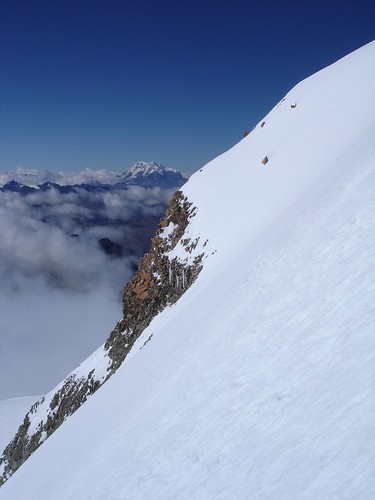
La Paz, 23th May 2007
At end also the Pequeño Alpamayo was climbed. It was much more than difficoult than I expected and for various reasons. I was very tired - I had rested less than two days since the end of the last climb - and quite sick as it is now two weeks that I have an annoying cold.
However the will to overcome my current personal situation made me ignoring my poor physical condition. Also having solo-climbed the mountain did not make the whole thing easier.
Unfortunately things get tougher exactly when we are weaker. During the approach to the base camp of the Pequeño Alpamayo I slipped on the wet grass and fell in pond of cold water. It was six in the afternoon and the Sun had just started to hide back of the highest mountains. I found myself at almost five thousands metres, wet and exposed to a cold and bitter wind. In a few minutes my body got close to hypothermia and my hands almost frozen. I found the energy to open my rucksack, take the sleeping-bag and get in it. After two hours spent in the sleeping-bag my body recovered and I could been able again to control my muscles. I had a frugale dinner, a lot of water and then I prepared mentally to my climb. After a few hours of very poor sleep I waked-up. A fine ice layer had covered the sleeping-bad. I forgote to say that to climb with the lighest equipment I had decided not to take my tent. Unfortunately the night had been much colder than I expected. Seeking the energy in the desire to emerge from my current awful time I went out of my warm sleeping-bag, dressed and equipped and despite a nausea and a strong throat-ache I starteed to hike in the direction of the base camp that I could not get a few hours before. After one hour I passed the base camp and saw on the glacier of the Pequeño Alpamayo some fare lights, surely other alpinists climbing the same mountain. The possibility not to be alone in such a place warmed my hearth. Another thirty minutes and I arrived on the shore of the lake generated by the fusion of the glacier; at this point I realised the lights were getting closer and closer. Little time after I met with a Bolivian guide and two French alpinists. Theirs words: "Il fait trop froid aujourd'hui et de plus nous ne sommes pas trop bien" ("today it is too cold and we do not feel very well"), sounded in my head like a direction to follow. The common sense was clearly indicating that I should have get back to my sleeping-bag and wait the Sun warming up my body weak and cold. I decided to continue my hike on the glacier; I crossed two dangerous crevasses and after two more hours of easy climb on the glacier I arrived on a ridge, face to the beautiful and imposing ice pyramid of Pequeño Alpamayo. I did not think twice and started working with my two ice tools along the ridge of the mountain. Exactly when I started my climb the Sun rised and started to warm me up. Minute after minute it got warmer than the icy winf that had not stopped to blow since the evening of the day before. After fourty minutes I was again on the top of a mountain. I took a few pictures and just after started to down-climb with all my energy in the direction of the place where I had spent the night before.
On the way back I met the Bolivian guide and the two French met before dawn. They told none of the three would have bet a penny on me on the summit.
Now I am in La Paz, with a strong fever and alone in the room of an hostel. I think I will need to wait several days before I can climb another mountain, but really I can't wait to start again.
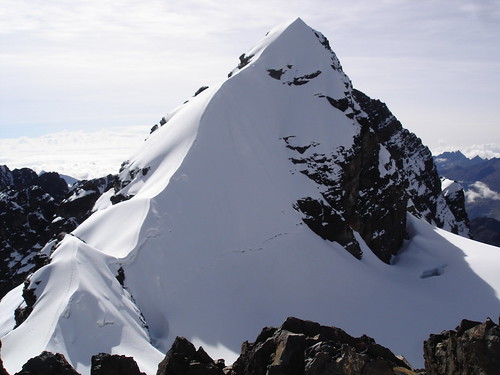
Campo base del Condoriri, 1st June 2007
My body took several days to recover from the last climb. However after a few days spent resting in Copacabana, a settlement on the shore of the Titicaca lake, the moutain and its immensity called me. I have just met some nice people, a couple of climbers from California, Yoav ed Ilona. Two days ago we left La Paz with the objective to climb Condoriri, one of the most beautiful mountains of the Andes.
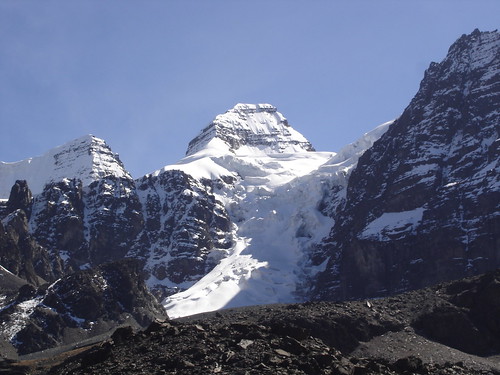
After a day spent to acclimatize to the altitude - the base camp of Condoriri, the same of Pequeño Alpamayo, is at about 4,700 metres of height - today at 1am we started the climb.
The temperature at the start was very mild but the air will get colder during the night. To arrive on the summit of Condoriri it is necessary to climb a very exposed ridge. It is compulsory to arrive on the summit just after sunrise and redescend before the snow turns to sugar. There is not the smallest rocky hold on the ridge and if the snow, under the action of the Sun, gets too soft it is impossible to stop any fall.
After two hours of hike we found ourselves face to a nasty scree slope with a gradient of fourty degrees. It is sad, but following the recent climate change, many sections that untill twenty years ago were on ice now are on rock and this makes things much less pleasant and certainly harder. During the hike on this nasty terrain Yoav starts to fell unwell, probably a pain of digestive origin (with the food and water of Bolivia this is unfortunately a regular occurance). After ten minutes Yoav decides to leave the group and return to the base camp. After a brief consultation with Yoav, Ilona and I decide to continue the climb
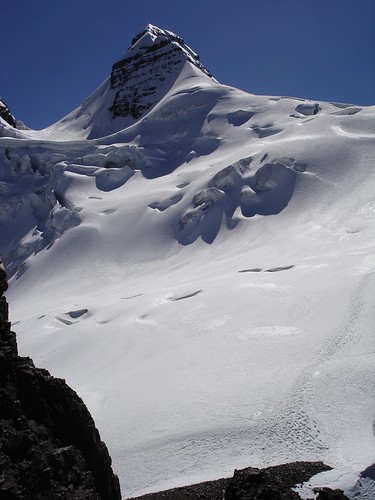
In short time - but hard job - we get quickly in proximity of the glaciated zone. We rope ourselves and start to to hike on the Condoriri's glacier, white and compact. Two hours more and we get, under dawn's light, to the technical section of the climb. We climb a snow and ice gully and finally we are on Condoriri's summit ridge. As soon we get on the ridge a strong wind from West starts to blow making everything harder. Ilone is a very competent climber but is also very light and the snow is not very hard. All that to say that in the event of a fall she would be only partially able to take my weight and very likely the both of us would get in the void. Quite scared I start to climb; Ilona gives me rope as long I climb on the ridge, narrow as the blade of a razor. After a couple of lenghts I get to the crux of the route, a rocky spur emerges exactly where the slope is over sixty-five degrees. I'd like to cross the entire section without any protection but I am too scared. Just under the rocky spur I decide to put a snow-stake but I find uneasy to do it without unbalancing my body. I must not move roughly, I need to be smooth in my actions. I mange to get the snow-stake from the rucksack, I put it in the snow where it looks more solid and helping myself with my theeth I pass the rope in the karabiner. Finally I manage to cross this steep section and everything is now different. In proximity of the summit the ridge's gradient gets more moderate and avoiding some minor difficulties in less than fifteen minutes we are on Condoriri's summit celebrating our victory.
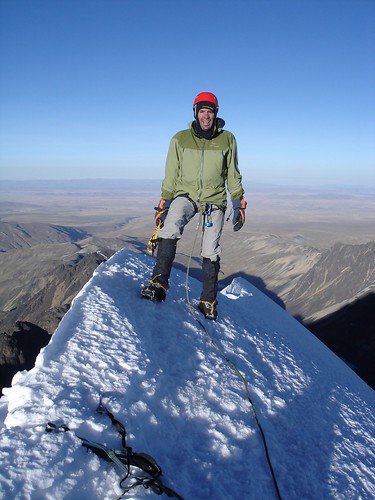
We need to take the biggest care on the descent. We are well conscious of the risks and keep our concentration very high. Metre after metre we down-climb the ridge with absolute metodicity and precision and we put anchors at the end of any length.
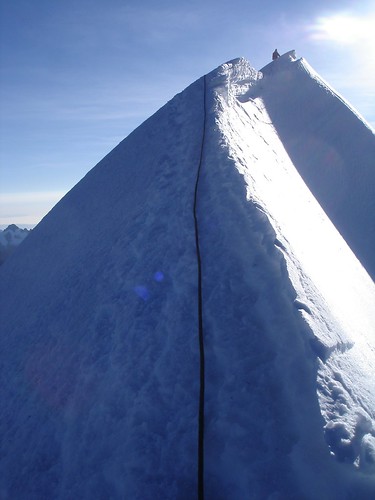
After one hour we get to the top of the snow and ice gully that we negociate rappelling with the rope belayed on two pitons and a 6mm rope loop. The rest of the descent is just a mule's job, we get back to the base camp by noon. Right now I am in my sleeping-bag writing down the crucial moments of this day. It is 3pm and in less than an hour the sleep will take possession of me. I hope it will not abandon me before tomorrow, because now it is really time to rest.
The last mountain, Nevado de Chañi, was climbed about a month ago. Perhaps more than a reader of this blog was wandering why for such a long time this blog had not been updated and no pictures were uploaded on my web site. Well, I just spent four intense weeks in Buenos Aires and in the south of Bolivia doing something else than mountaineering. I feel quite safe saying it had been quite a while since I had felt so engaged for someone. I know that climbing again I will find the motivation and the energy to overcome the current difficult time.
I have been in La Paz (Bolivia) for a few days and I started again climbing full-time. Yesterday, in less than twenty-four hours, I climbed the Huayna Potosi a mountain of 6,088 metres located near La Paz. In two days I leave the city to climb the Pequeño Alpamayo, a smaller but beautiful mountain but if I believe to the opinion of the most.
I will be in Bolivia climbing untill June the 12th and afterwards I will move to Huaraz in Peru where I expect to stay for about five weeks. In Huaraz I will meet Mike, an alpinist from California with whom I climbed extensively in the Mont Blanc area.

La Paz, 23th May 2007
At end also the Pequeño Alpamayo was climbed. It was much more than difficoult than I expected and for various reasons. I was very tired - I had rested less than two days since the end of the last climb - and quite sick as it is now two weeks that I have an annoying cold.
However the will to overcome my current personal situation made me ignoring my poor physical condition. Also having solo-climbed the mountain did not make the whole thing easier.
Unfortunately things get tougher exactly when we are weaker. During the approach to the base camp of the Pequeño Alpamayo I slipped on the wet grass and fell in pond of cold water. It was six in the afternoon and the Sun had just started to hide back of the highest mountains. I found myself at almost five thousands metres, wet and exposed to a cold and bitter wind. In a few minutes my body got close to hypothermia and my hands almost frozen. I found the energy to open my rucksack, take the sleeping-bag and get in it. After two hours spent in the sleeping-bag my body recovered and I could been able again to control my muscles. I had a frugale dinner, a lot of water and then I prepared mentally to my climb. After a few hours of very poor sleep I waked-up. A fine ice layer had covered the sleeping-bad. I forgote to say that to climb with the lighest equipment I had decided not to take my tent. Unfortunately the night had been much colder than I expected. Seeking the energy in the desire to emerge from my current awful time I went out of my warm sleeping-bag, dressed and equipped and despite a nausea and a strong throat-ache I starteed to hike in the direction of the base camp that I could not get a few hours before. After one hour I passed the base camp and saw on the glacier of the Pequeño Alpamayo some fare lights, surely other alpinists climbing the same mountain. The possibility not to be alone in such a place warmed my hearth. Another thirty minutes and I arrived on the shore of the lake generated by the fusion of the glacier; at this point I realised the lights were getting closer and closer. Little time after I met with a Bolivian guide and two French alpinists. Theirs words: "Il fait trop froid aujourd'hui et de plus nous ne sommes pas trop bien" ("today it is too cold and we do not feel very well"), sounded in my head like a direction to follow. The common sense was clearly indicating that I should have get back to my sleeping-bag and wait the Sun warming up my body weak and cold. I decided to continue my hike on the glacier; I crossed two dangerous crevasses and after two more hours of easy climb on the glacier I arrived on a ridge, face to the beautiful and imposing ice pyramid of Pequeño Alpamayo. I did not think twice and started working with my two ice tools along the ridge of the mountain. Exactly when I started my climb the Sun rised and started to warm me up. Minute after minute it got warmer than the icy winf that had not stopped to blow since the evening of the day before. After fourty minutes I was again on the top of a mountain. I took a few pictures and just after started to down-climb with all my energy in the direction of the place where I had spent the night before.
On the way back I met the Bolivian guide and the two French met before dawn. They told none of the three would have bet a penny on me on the summit.
Now I am in La Paz, with a strong fever and alone in the room of an hostel. I think I will need to wait several days before I can climb another mountain, but really I can't wait to start again.

Campo base del Condoriri, 1st June 2007
My body took several days to recover from the last climb. However after a few days spent resting in Copacabana, a settlement on the shore of the Titicaca lake, the moutain and its immensity called me. I have just met some nice people, a couple of climbers from California, Yoav ed Ilona. Two days ago we left La Paz with the objective to climb Condoriri, one of the most beautiful mountains of the Andes.

After a day spent to acclimatize to the altitude - the base camp of Condoriri, the same of Pequeño Alpamayo, is at about 4,700 metres of height - today at 1am we started the climb.
The temperature at the start was very mild but the air will get colder during the night. To arrive on the summit of Condoriri it is necessary to climb a very exposed ridge. It is compulsory to arrive on the summit just after sunrise and redescend before the snow turns to sugar. There is not the smallest rocky hold on the ridge and if the snow, under the action of the Sun, gets too soft it is impossible to stop any fall.
After two hours of hike we found ourselves face to a nasty scree slope with a gradient of fourty degrees. It is sad, but following the recent climate change, many sections that untill twenty years ago were on ice now are on rock and this makes things much less pleasant and certainly harder. During the hike on this nasty terrain Yoav starts to fell unwell, probably a pain of digestive origin (with the food and water of Bolivia this is unfortunately a regular occurance). After ten minutes Yoav decides to leave the group and return to the base camp. After a brief consultation with Yoav, Ilona and I decide to continue the climb

In short time - but hard job - we get quickly in proximity of the glaciated zone. We rope ourselves and start to to hike on the Condoriri's glacier, white and compact. Two hours more and we get, under dawn's light, to the technical section of the climb. We climb a snow and ice gully and finally we are on Condoriri's summit ridge. As soon we get on the ridge a strong wind from West starts to blow making everything harder. Ilone is a very competent climber but is also very light and the snow is not very hard. All that to say that in the event of a fall she would be only partially able to take my weight and very likely the both of us would get in the void. Quite scared I start to climb; Ilona gives me rope as long I climb on the ridge, narrow as the blade of a razor. After a couple of lenghts I get to the crux of the route, a rocky spur emerges exactly where the slope is over sixty-five degrees. I'd like to cross the entire section without any protection but I am too scared. Just under the rocky spur I decide to put a snow-stake but I find uneasy to do it without unbalancing my body. I must not move roughly, I need to be smooth in my actions. I mange to get the snow-stake from the rucksack, I put it in the snow where it looks more solid and helping myself with my theeth I pass the rope in the karabiner. Finally I manage to cross this steep section and everything is now different. In proximity of the summit the ridge's gradient gets more moderate and avoiding some minor difficulties in less than fifteen minutes we are on Condoriri's summit celebrating our victory.

We need to take the biggest care on the descent. We are well conscious of the risks and keep our concentration very high. Metre after metre we down-climb the ridge with absolute metodicity and precision and we put anchors at the end of any length.

After one hour we get to the top of the snow and ice gully that we negociate rappelling with the rope belayed on two pitons and a 6mm rope loop. The rest of the descent is just a mule's job, we get back to the base camp by noon. Right now I am in my sleeping-bag writing down the crucial moments of this day. It is 3pm and in less than an hour the sleep will take possession of me. I hope it will not abandon me before tomorrow, because now it is really time to rest.